An earlier article (Projecting Player Performance – Method) explained how player projections are made, using a process called Player Projection Method (PPM). This article will show projections for several players who are presented in order of age. We will start with young players who are still improving, we’ll gradually move to players who are at or near their career peak, and we’ll finish with players who have had long careers and are in their period of decline.
Before we get to the players, I’ll show a sample of the Projection Table, which is presented for each player.
Projection Table


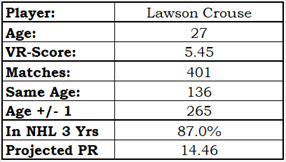
The top part of the projection table shows a player’s history while the bottom part shows projection information.
The history is a player’s Career Productivity Rating Chart and his Career Value Rating Chart. PR charts can be quite “bumpy” while VR charts tend to be “smoother.”
The left side of the second row shows where the projected player would find himself on a typical 18-skater team: Crouse projects to be the 12th best skater, which is a third-line forward. The right side of the second row has a table which contains facts about the projection.
Projection – Logan Cooley, 20

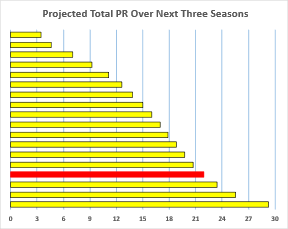
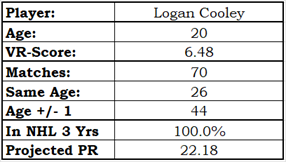
We are starting with the 20-year-old player who had the highest VR-Score in 2024-25.
Cooley had 70 matches, and that means player-seasons rather than unique players. If a player had VR-Scores between 5.98 and 6.98 in his age-19, age-20 and age-21 seasons, he would provide three matches (a triple match). For Cooley, that happened three times.
Cooley’s triple matches are Nathan MacKinnon (VR-Scores of 6.37, 6.54 and 6.75), Nico Hischier (6.43, 6.46, 6.08) and Zach Bogosian (6.20, 6.11, 6.84).
MacKinnon didn’t hit his full stride until his age-22 season and Hischier didn’t hit it big until his age-23 season. Begosian’s two best seasons came at age 19 and 21. The future of players in a matching group features a wide range of results. They can range from excellence to disaster, the latter usually caused by injuries.
Cooley projects to be a first-line forward.
Projection – Wyatt Johnston, 21

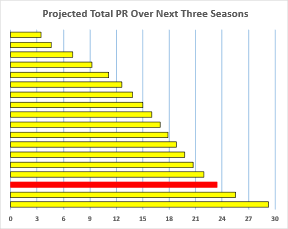
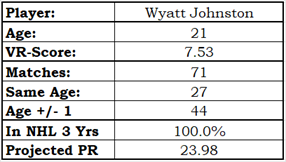
Let’s continue with another good young player, Wyatt Johnston, who has the highest VR-Score among players aged 21.
Johnston’s group of matching player has no overlap with Cooley’s matching group. Cooley’s matches had a maximum VR-Score of 6.98 while Johnston’s matching group had a minimum VR-Score of 7.03.
Johnston’s projection is only marginally better than Cooley’s, and that is a bit of a surprise given the gap in their VR-Scores. This is, in all probability, related to the small number of matches each player has: Cooley has 70 matches, Johnston has 71. I would be more comfortable with the projections if each had more than 100 matches, but there won’t be 100+ matches to these players until the 2032-33 season at the earliest. I didn’t want to wait seven years to publish this article.
Johnston projects to be a first-line forward.
Projection – Seth Jarvis, 22

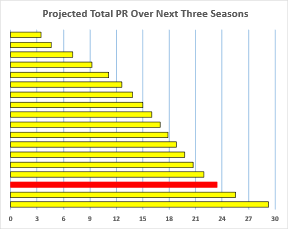
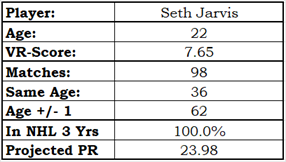
Again we have a situation where the projection does not quite correspond to subjective concepts. Seth Jarvis is a year older than Johnston and has a very slightly higher VR-Score (7.65 to 7.53). His projected PR-Score is identical to Johnston: 23.98, which is 7.99 per season, which is the very top of the PR-First5 category.
While Johnston and Cooley had no commonality in their matching group, Jarvis and Johnston have a lot of matches in common. Just over half of Jarvis’s matching group (52 player-seasons) were also in Johnston’s matching group.
When I first saw these two players projections, my subjective mind said that Jarvis should have a better projection because he is a year older and has a slightly higher VR-Score. Both players are still in the stage of their careers where season-to-season improvements are expected, and Jarvis’s VR-Score advantage should influence the projection.
My second thought was that Jarvis’s slightly higher VR-Score wasn’t enough higher to matter, that he is essentially “on track” with Johnston’s expected progress, and so it is natural that they share the same projection.
Jarvis projects to be a first-pair defenceman, a #1D.
Projection – Arber Xhekaj, 23

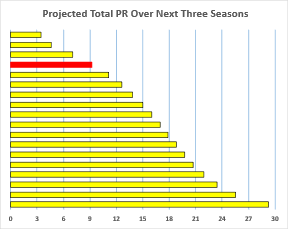
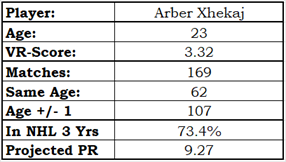
Xhekaj projects to be a bottom pair defenceman, not that I’m going to tell him to his face.
Is it surprising that fully one-quarter of players that were close to him in age and VR-Score were not playing three seasons later? It shouldn’t be. His VR-Score is 3.32, which puts him in the VR-Fringe category. Being a fringe player makes one replaceable.
If Montreal has a defenceman in the minors that looks like he might score 10 goals in the NHL, he’ll take Xhekaj’s position on the team faster than you can calculate the Scrabble score of Xhekaj’s name. Which is 27 points, in case you were wondering.
Projection – Rasmus Dahlin, 24

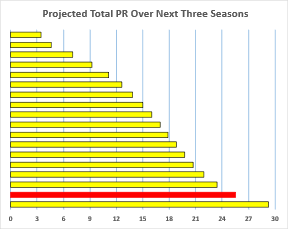

Now we go from the ridiculous to the sublime.
Better players have fewer matches than average or lowly ranked players, because there are fewer great players than there are good players.
As with all players, some of the matchers are matches several times. Four players are matches to Dahlin three times, meaning in their age-23, age-24 and age-25 season they have VR-Scores between 9.26 and 10.26. Those four players are: Aleksander Barkov, Alex Pietrangelo, Anze Kopitar and Nathan MacKinnon. Dahlin has some lofty company.
Dahlin projects to be a #1 defenceman over the next three seasons.
Projection – Robert Thomas, 25


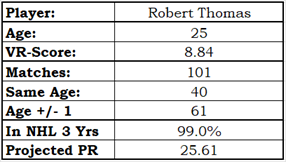
There are fourteen potential donor seasons for a player-of-interest’s matching group, 2008-09 to 2021-22. 2007-08 cannot be a matching season because it is the first season for which the data needed to calculate PR and VR are freely available, and no player could play 123 games that season (123 is half of three seasons of games).
Robert Thomas has 101 players in his matching group, which works out to an average of seven matching players per season. I checked 2024-25 data, and luckily enough there were seven matches to Thomas: Nico Hischier, age 25, VR-Score 9.20; Nick Suzuki, 25, 8.91; Jason Robertson, 25, 8.67; Evan Bouchard, 25, 8.56; Elias Pettersson, 26, 9.11; Brandon Hagel, 26, 8.85 and; Clayton Keller, 26, 8.40.
Robert Thomas projects to be a first-line forward.
Projection – Brandon Hagel, 26

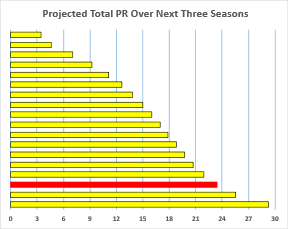
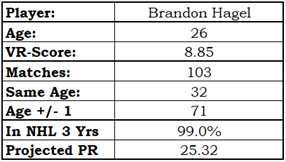
To give you an idea of how much VR-Score matters in a projection, I will show you the projections of two players who are 26 years old but who have very different VR-Scores.
Brandon Hagel is the better of the two. Both his PR and VR charts could serve as idealized examples of what those charts should look like. He has played almost every game that was scheduled in the last five seasons and has gotten better each of those seasons.
Hagel projects as a first-line forward.
Projection – Nick Perbix, 26

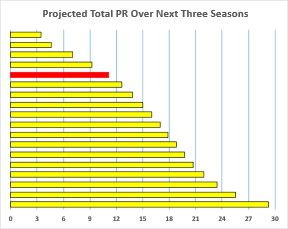
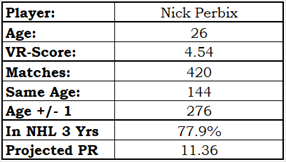
The second 26-year-old is Nick Perbix, who was a teammate of Hagel’s in Tampa Bay last season.
One thing to notice immediately is that Perbix has played in only three seasons (Hagel has played five full seasons). Better players usually start their NHL careers at a younger age.
Probably, Perbix has already hit his career maximum performance. Sure, he could still improve, but he won’t improve much. It is almost inconceivable that he could make it into the PR-First5 category in 2025-26, which would require him to play at the level of a #2 defenceman.
Perbix projects to be a #5 defenceman over the next three years. If his play slips a bit, he’ll make himself replaceable.
Projection – Anthony Cirelli, 27

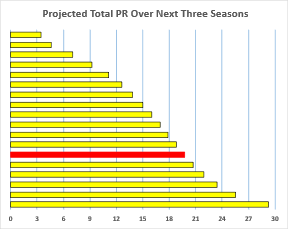
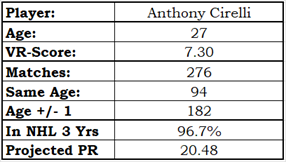
The next two projections are paired, featuring players of the same age and same VR-Score.
Anthony Cirelli would have a higher rating had he not missed a total of half-a-season’s worth of games in his last seven seasons, but he did miss those games.
He projects to be a good second-line forward.
Projection – Thomas Chabot, 27

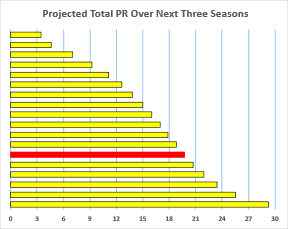
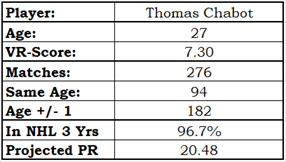
Thomas Chabot is our second 27-year-old VR-Score-7.30 player.
As with Cirelli, Chabot has missed games these last seven seasons, but more like a full season’s worth of games. While both Cirelli and Chabot would have preferred more idealized career paths, their broken roads have led them straight to where they are now (to paraphrase a Rascall Flatts song). In terms of VR-Score, they are just outside the top 100 in the league.
Comparing the data table on the bottom right for both players, the only difference you will find is their names. In spite of playing different positions, in spite of different successes and inconsistencies in their careers, they have the same set of matching players because they are both 27 years old with a VR-Score of 7.30.
I did check to see if projections would be different if matches were restricted to players who played the same position, and the differences were not consistent and were usually trivial. Sometimes the forwards of a certain age projected better, sometimes the defencemen projected better. The variations struck me as vagaries related to sample size, rather than being caused by the positions players played.
Chabot projects as a strong second-pair defenceman.
Projection – Mikko Rantanen, 28

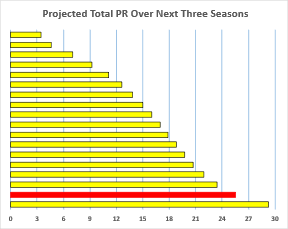
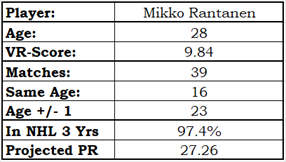
Mikko “Suitcase” Rantanen was the most valuable player who was traded in 2024-25. He was also one of the most traded players in 2024-25, having been traded twice.
As he is an excellent player, he has very few matches: just 39.
Based on a mix of intuition and experience, I decided not to show projections for players that had fewer than 25 matches. This rules out McDavid, Matthews and Makar, amongst others. There simply aren’t enough players like them to tell us much about what happens to players like them.
Rantanen projects to be a first-line player, one of the two best players on his team. I’d trade for him.
Projection – Curtis Lazar, 29

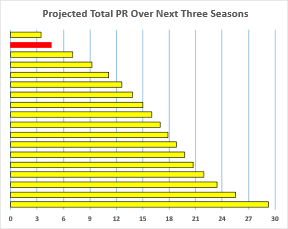
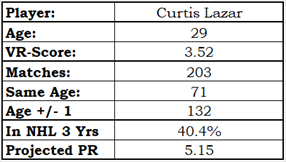
As with many people in Ottawa, I really wanted Curtis Lazar to be a good player. He had great chemistry with the fan base, including, but not limited to, a post-game celebration when he scarfed down a hamburger that somebody had tossed on the ice. That “Hamburglar” run was something else!
But it is what it is and he is what he is: a personality that is off-the-charts good combined with Fringe-level NHL skills.
He projects as a fourth-line forward, which makes him eminently replaceable.
Projection – Michael Matheson, 30

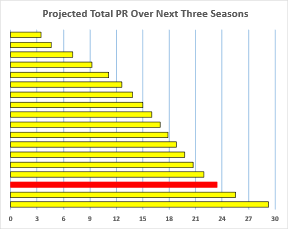
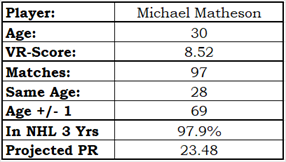
The Career Productivity Rating Chart shows that Matheson had a huge improvement late in his career. What happened in 2023-24? It was a continuation of something that happened in 2022-23: his arrival in Montreal.
In his last season in Pittsburgh (2021-22), he was fighting for ice time with Kris Letang, John Marino and Brian Dumoulin. He was played as their fourth best defenceman, so he got the ice time that is usually given to a #4 D, which affected PR-Score. PR-Score is based on statistical counts (1,230 minutes played), not on rates (15 minutes per game), and you cannot accumulate statistical counts while sitting on the bench.
In the summer of 2022 he was traded to Montreal. He went from being the #4 defenceman to the #1 defenceman. He went from playing 19 minutes per game to 25 minutes, and he did well offensively. Subjectively, I don’t think Matheson improved when he moved to Montreal. He simply got the chance to play at a level he could have played at earlier. In retrospect, Pittsburgh may well have undervalued him.
He projects to be a #1 defenceman. Even though he plays for Montreal, I’m happy for him and his late career successes.
Projection – J.T. Miller, 31

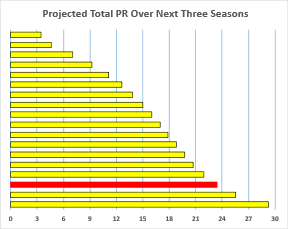

J.T. Miller is the 2024-25 traded player with the second-highest VR-Score. He went from one disappointing team to another disappointing team. Both teams were expected to make the playoffs at the start of the season, and neither team made the playoffs.
Miller’s 2024-25 dip in PR-Score is largely related to having missed 10 games. Yet even had he played a full 82 games at his season pace, his PR-Score would have been below his four best seasons.
Is this the start of an age-related decline, or was 2024-25 a season of bad luck and injury? The player projection method has no answer to that question. The statistics show he was less productive, but they don’t say why he was less productive.
Miller projects as a first-line forward.
Projection – Bryan Rust, 32


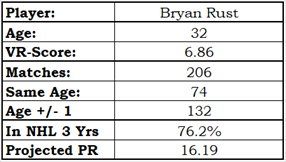
Bryan Rust shows the impact on projections when you are one year older and one VR category lower than somebody else (J.T. Miller).
Obviously, no same person would have thought these players were equals: Miller is clearly the better player. But the projections of two players like these gives credibility to PPM, as the better player has the better projection.
Rust projects to be a middle-six forward, a good third-liner. He has a one-in-four chance of being out of the NHL in three years time.
The good news for him is that his PR-Score has been improving these last several seasons, which shows that his age-related decline has not yet begun. One could guess this means he has a better chance of retaining his value going forward. I haven’t looked at that issue because it is a non-trivial amount of work.
Projection – Erik Haula, 33

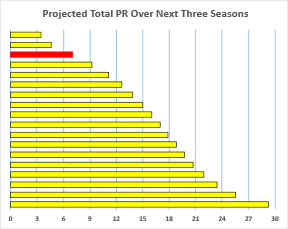
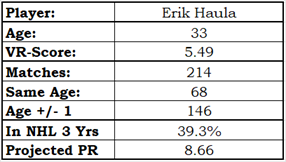
I chose to look at 33-year-old Erik Haula’s future because his VR-Score is similar to Logan Crouse (the main example used in the Projecting Player Performance – Method article) but he is significantly older (33 vs. 27).
Six years older is significant difference? In terms of playing professional sports, that is a huge difference.
Haula’s Career Productivity Rating chart gives the impression that he is moving into age-related decline. He missed 13 games in 2024-25, but his 82-game pace for PR-Score is still below his 2023-24 season.
Haala’s projection is not rosy. He projects to be a fourth-liner, and has a 60% chance of not playing three years into the future. He is approaching the PR-Fringe level of play, where an older expensive player will be replaced with a younger inexpensive player.
Projection – Nick Jensen, 34


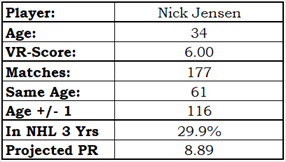
This article will finish with three players who have almost identical VR-Scores with age differences of one year. All of them are approaching the ends of their careers.
Jensen’s VR-Score is somewhat inflated by his very good 2022-23 season. The decline in his last two seasons is almost certainly age-related, and age cannot be fixed.
Jensen projects to be a third-pair defenceman who will probably slip into the PR-Fringe category this season or next.
Projection – Ian Cole, 35

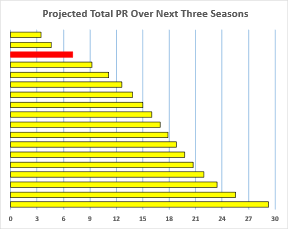
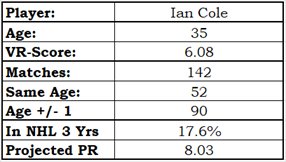
This projection seems to be in contradiction with his statistics. In the last five seasons, Cole has played for six different teams: Colorado, Minnesota, Carolina, Tampa Bay, Vancouver and Utah. After a significant drop in PR-Score in 2019-20, he has improved every season since. In 2024-25, he rates as a VR-First5, a category he last saw in 2019-20 as a spry young 30-year-old. Has he found the fountain of youth?
His projection (third-pair defenceman, 17.6% chance of playing three seasons from now) is not based on his progress since 2019-20. It is solely based on his VR-Score and his age.
His age and VR-Score led to 142 matches, and the future of that group led to his projection. I didn’t check, but I would not be the least bit surprised if none of the 142 matching players had improved every season from age 30 to age 35. I would imagine that most of them have been declining for a few seasons as they entered their age-35 season.
Objectively, he projects to be a third-pair defenseman playing at the bottom of the PR-Regular range next season and quickly slipping into the PR-Fringe range. Subjectively, it feels like Cole’s projection is pessimistic.
Projection – Jordan Staal, 36

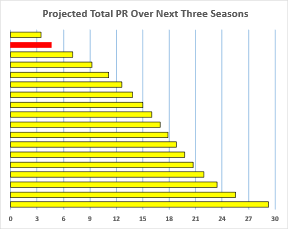
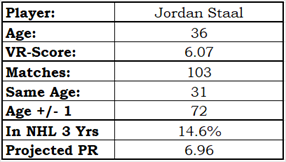
The last projection goes to Jordan Staal, a guy who has been playing so long that he has played with a guy (Gary Roberts) who played with a guy (Lanny McDonald) who played with a guy who won the Stanley Cup with Toronto in 1967 (Dave Keon). In a few more links, we’d find players who played for the Montreal Maroons and New York Americans.
While his PR-Chart has gaps that were associated with multiple missed games in a season, his VR-Chart has been a model of consistency. He has aged gently.
Staal projects to be a fourth-line player (as he is now, truth be told) and has a one-in-seven chance of still playing in the 2027-28 season.
Summary
In this article (which sets a record for pages in a Stapled to the Bench article), I hope to have shown that PPM is a useful tool. The projections PPM produces agree with subjective perceptions of players in general: younger players improve, older players decline.
The reason PPM projections for older players are less than those for younger players of the same skill level is not because we subjectively feel that that should happen, but because that is what has happened. PPM projections mirror reality.
In a related article, I will examine a couple of players from each of the Canadian teams. To be specific, the players were on Canadian teams at the end of the regular season, and they may no longer be on Canadian teams now.
Related Articles
Projecting Player Performance – Method
Projecting Player Performance – Canadian Teams
